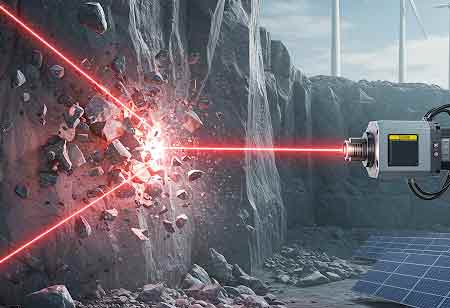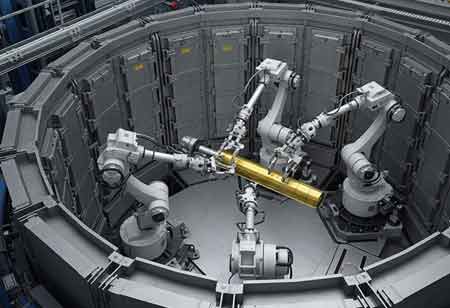CLOSE
Specials
I agree We use cookies on this website to enhance your user experience. By clicking any link on this page you are giving your consent for us to set cookies. More info
Be first to read the latest tech news, Industry Leader's Insights, and CIO interviews of medium and large enterprises exclusively from Energy Tech Review
Thank you for Subscribing
Innovations in Rock-Fracturing Technologies for the Energy Sector
The ability to fracture rock formations efficiently and precisely is fundamental to the energy sector.

By
Energy Tech Review | Monday, August 18, 2025
Stay ahead of the industry with exclusive feature stories on the top companies, expert insights and the latest news delivered straight to your inbox. Subscribe today.
The ability to fracture rock formations efficiently and precisely is fundamental to the energy sector. Whether unlocking traditional hydrocarbon reserves buried miles beneath the surface, harnessing deep geothermal energy, or enabling subsurface storage solutions, rock-breaking technologies serve as critical enablers. Far from a static discipline, this domain is a frontier characterized by continuous innovation, driven by the increasing complexity of resource environments and the imperative for improved operational efficiency and precision.
Today’s industry landscape reflects a sophisticated interplay between refined conventional techniques and rapidly emerging novel approaches, increasingly augmented by digital intelligence and automation.
Mechanical Foundations: Optimizing Conventional Techniques
Mechanical rock breaking—primarily through rotary and percussive drilling—remains a cornerstone of subsurface access. Decades of advancement have yielded highly optimized systems, yet innovation persists. Progress in materials science continues to enhance the performance and durability of drill bits and downhole components, which is especially critical in hard, abrasive, or high-temperature formations commonly encountered in deep or geothermal drilling. Downhole motors and drive systems are achieving incremental gains in efficiency, enabling better energy transfer and improved penetration rates.
Beyond mechanical hardware, integrating advanced sensor technologies directly into drilling assemblies is transforming performance. Real-time measurements of key parameters—such as weight-on-bit, torque, vibration, and temperature—feed into sophisticated control systems capable of autonomously optimizing drilling parameters, mitigating damaging vibrations, and enhancing situational awareness. This data-centric approach, often termed “digital drilling,” represents a shift toward precision-guided mechanical excavation, informed by advanced modelling of rock-tool interactions.
Hydraulic Fracturing: Enhancing Reservoir Connectivity
Hydraulic fracturing—using pressurized fluid to induce or extend fractures in rock—has reshaped the energy landscape by enabling the commercial viability of low-permeability formations such as shale. While the fundamental principle remains unchanged, modern hydraulic fracturing emphasizes precision, efficiency, and minimal environmental impact. Advanced geological modelling and simulation tools now facilitate accurate prediction of fracture propagation, optimizing treatment design for enhanced reservoir contact.
Innovations in fracturing fluids and proppants continue to improve fracture effectiveness and durability. Fluids are increasingly tailored to specific geologic and reservoir conditions, minimizing formation damage while maximizing conductivity. Proppant development focuses on mechanical strength, conductivity, and efficient transport under high closure stresses. Additionally, real-time fracture monitoring techniques—such as microseismic mapping—offer immediate feedback, enabling dynamic adjustment of stimulation parameters and deeper insight into subsurface behavior.
Thermal and Chemical Innovations
Complementing mechanical and hydraulic methods, thermal and chemical techniques offer alternative strategies for rock breaking. Thermal spallation, which uses intense localized heating to cause rock flaking, is particularly effective in crystalline formations. Research into laser and plasma-based drilling systems continues, with significant relevance for high-temperature geothermal applications. Microwave-assisted drilling is also being explored for its ability to weaken rock structures by selectively heating mineral constituents, thereby reducing the energy required for mechanical excavation.
Chemical approaches, such as expanding grouts or reactive agents, provide non-explosive solutions for controlled rock breaking. These techniques are especially valuable in sensitive environments or precision applications, offering high degrees of control with reduced vibration and noise. Though generally slower than other methods, chemical solutions are indispensable in specific intervention or remediation scenarios.
Emerging Techniques and Novel Frontiers
The pursuit of more efficient, versatile, and environmentally responsible methods is driving the exploration of novel technologies. High-pressure water jetting—sometimes enhanced with abrasives—uses focused fluid streams to cut or erode rock. Advances in ultra-high-pressure pump technology and nozzle design are expanding the scope of this technique, including its integration with mechanical systems.
Electrical methods offer additional promise. Electrohydraulic and direct-pulse technologies leverage high-voltage discharges to create shockwaves or intense localized heating, effectively fracturing rock. Electrical disintegration techniques exploit conductive pathways within rock to induce thermal stress or phase transformation, yielding targeted fracturing.
Sonic and ultrasonic approaches use high-frequency vibrations to induce fatigue and micro-fracturing in rock materials. Ongoing research seeks to optimize frequency ranges and energy delivery methods, potentially enabling these technologies to serve as primary or complementary rock-breaking solutions.
Integration and Hybridization: Combining Strengths
A prominent trend in the field is the integration of multiple rock-breaking modalities into hybrid systems. For example, rotary drilling may be enhanced with water jetting at the bit-rock interface for improved cuttings removal and cooling or with thermal pre-treatment—such as microwave heating—to weaken rock ahead of mechanical engagement. Percussive and rotary actions are also increasingly combined to capitalize on their strengths.
The Unifying Force of Digital Intelligence and Automation
The rapid integration of automation and AI redefines operational capabilities across all rock-breaking methods. Modern rigs have automated systems for rod handling and bit positioning, enabling greater consistency, safety, and round-the-clock operation.
Sensor-rich environments at the surface and downhole generate large volumes of real-time data. Machine learning and AI algorithms process this data to optimize drilling parameters, predict equipment wear, and anticipate anomalies. Digital twins—virtual models of physical systems—are increasingly used for pre-execution simulation and live operational optimization. Remote operation capabilities also advance, allowing centralized monitoring and control of field operations, which is particularly valuable in remote or hazardous environments.
Rock-breaking technologies are undergoing a period of vibrant evolution. While mechanical and hydraulic techniques continue to improve in sophistication and efficiency, alternative methods—thermal, chemical, electrical, and sonic—are maturing and expanding the toolkit available for specialized challenges. The broader integration of hybrid systems, automation, sensor technologies, and advanced analytics is reshaping how subsurface resources are accessed and managed.
These innovations are essential for optimizing current energy production and enabling future frontiers, such as ultra-deep geothermal development, large-scale subsurface hydrogen storage, carbon sequestration, and next-generation hydrocarbon extraction. Rock-breaking technologies remain central to meeting the world’s growing energy needs in this rapidly evolving landscape.

Copyright © 2025 Energy Tech Review. All rights reserved






